This week's best things
Ideas for purpose-driven leadership, trying to solve linkrot, the state of social media in 2024, design systems for neurodiverse users, immersive exhibitions, the emoji kitchen, how to leave Twitter, the first hashtag, ways of sharing data, AI invades internet dating, and more.

I'm on holiday for the next few weeks therefore this will be the last edition for September, so I made it a longer one than usual.
10 ideas for purpose-driven digital leadership in museums
"This toolkit seeks to ignite fresh perspectives on the nexus between digital technology, humanitarian principles and cultural institutions. Through ten key insights gleaned from the “digital dilemmas” public program at Musée international de la Croix-Rouge et du Croissant-Rouge, we hope that it will serve as both a source of inspiration and a roadmap for re-thinking museum practice. We need museums. This text makes the case for museums as critical infrastructure at the service of their communities."
Sadly it seems that the only way to access the toolkit in English at the moment is via Linkedin posts from the authors who include the excellent and smart Dr Oonagh Murphy.

How the Wayback Machine is trying to solve the web’s growing linkrot problem
This podcast episode from The Verge's Nilay Patel looks at the issue of linkrot (i.e. links that no longer resolve to the thing they were meant to link to), and speaks to Mark Graham, director of the Wayback Machine (a digital archive of the world wide web).
"In a lot of meaningful ways, large portions of the web are dying. Servers go offline, software upgrades break links and pages, and companies go out of business — the web isn’t static, and that means sometimes parts of it simply vanish."
/cdn.vox-cdn.com/uploads/chorus_asset/file/23318433/akrales_220309_4977_0182.jpg)
The State of Social in 2024
Via my colleague Katie's Digital Works newsletter "If you are responsible for managing your organisation's social media accounts, here's a useful, very long, compendium of the state of social in 2024".
Contains lots of useful thoughts, observations and insights from Matt Stasoff.
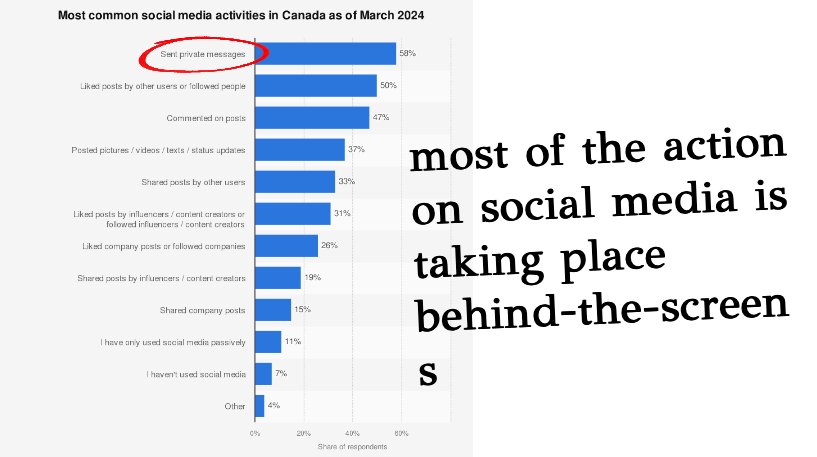
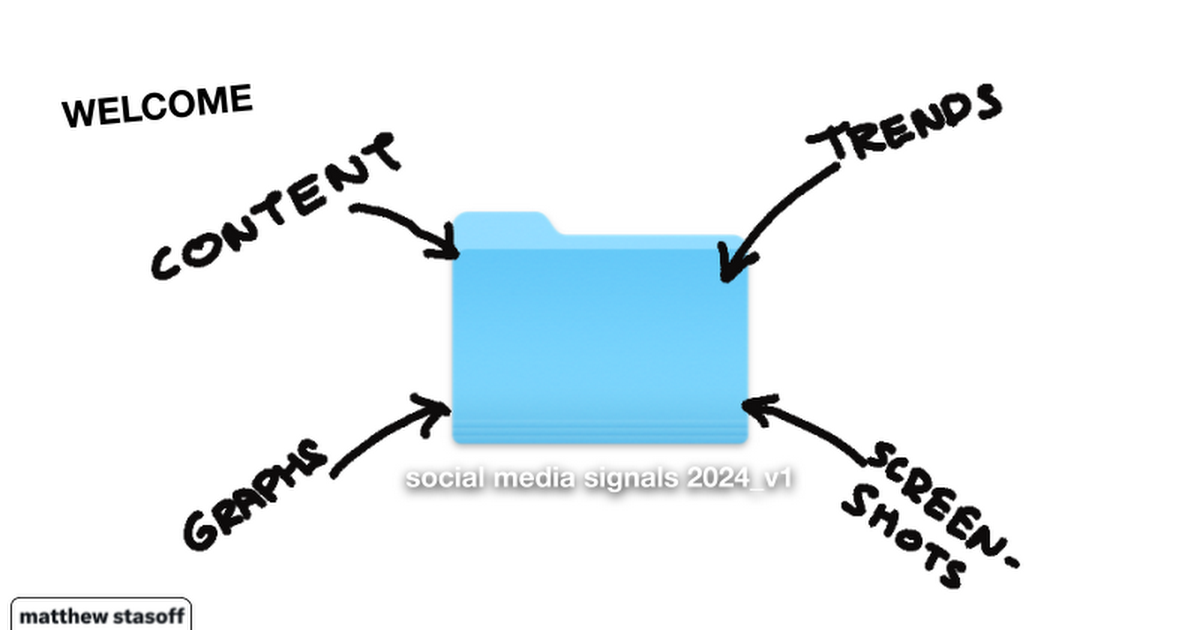
Onboarding visitors into immersive exhibitions
ACMI's Head of Experience, Digital and Insights, Lucie Paterson has written a post exploring how they went about onboarding visitors into their recent Marshmallow Laser Feast immersive exhibition.
The ideas that Lucie talks about around their visitor engagement model, being thoughtful and intentional about how you help visitors shift into a different mindset, and learning from the feedback you get are probably useful and relevant for all cultural organisations regardless of whether you're specifically planning immersive work or not.
"What we learnt from the layout of the start of the gallery has already informed future exhibition design.
We continue to learn through experimentation what works and what we can improve on. To help teams across ACMI put our visitors at the heart of our design we have established a series of Experience Principles to have a shared language and tools to support this important work."

The Emoji Kitchen
Google introduced some functionality to Android a couple of years ago that allowed you to mix emojis.
This website allows you to do that to your heart's content even if you don't have a device running Android, it's lots of fun.


Consciously uncoupling from Twitter/X
I saw a good thread this week from Rob Cawston about why he's leaving Twitter/X.
In his thread he cites a number of compelling reasons, and links to a bunch of things that are worth a read. However I wanted to specifically highlight a couple of things that look at how to leave X (and make it stick).
"the main thing is to go (almost) cold turkey. Just stop posting. Yes, you will miss the dopamine hits of dozens, hundreds or even thousands of retweets to your quips and pronouncements, but trust me, you will get over it. I swapped nearly 100,000 X followers for zero (now about 2,000) on Bluesky and decided to be a grown-up about it. Crucially, you will no longer be contributing to a platform thirsty for content and for ads and comfortable with a “both sides” approach to barefaced racism." "How to break up with your X" - Financial Times
"The cumulative effect of these norms on the user experience is stark. When I spend time on Blue Sky or Mastodon I find the quality of attention, and the mental state I’m left in, is completely different. When I go back to Twitter, which is rare now, the speed with which I’m infuriated is shocking. Once you notice this, and start realising Twitter is similar to other things with craving-and-regret cycles— smoking, bingeing— quitting gets easier." "How to leave Twitter" - James Plunkett

The first-ever hashtag, @-reply and retweet, as Twitter users invented them
And on the subject of Twitter, it's nice to think back to when it wasn't a total wreck. I saw this Quartz article crop up on Bluesky (where I'm now spending some time) and it is a nice recounting of the first example(s) of some of the behaviours that became integral to Twitter such as the hashtag, @-reply, and retweet.
"The first hashtag on Twitter, which he used as an example of the concept, was #barcamp—a loosely organized series of technology conferences that he helped to create. Messina later elaborated on the idea in a blog post, even drawing up designs of what the feature could look like on Twitter. He called them “channels.” Writer Stowe Boyd proposed the name “hash tags.”
Not many people were impressed. Some thought hashtags were ugly and unnecessary. Twitter executives deemed the idea “too nerdy,” according to Messina. But there were early triumphs, like when people coalesced around the hashtag #sandiegofire to tweet about wildfires that occurred in October 2007."
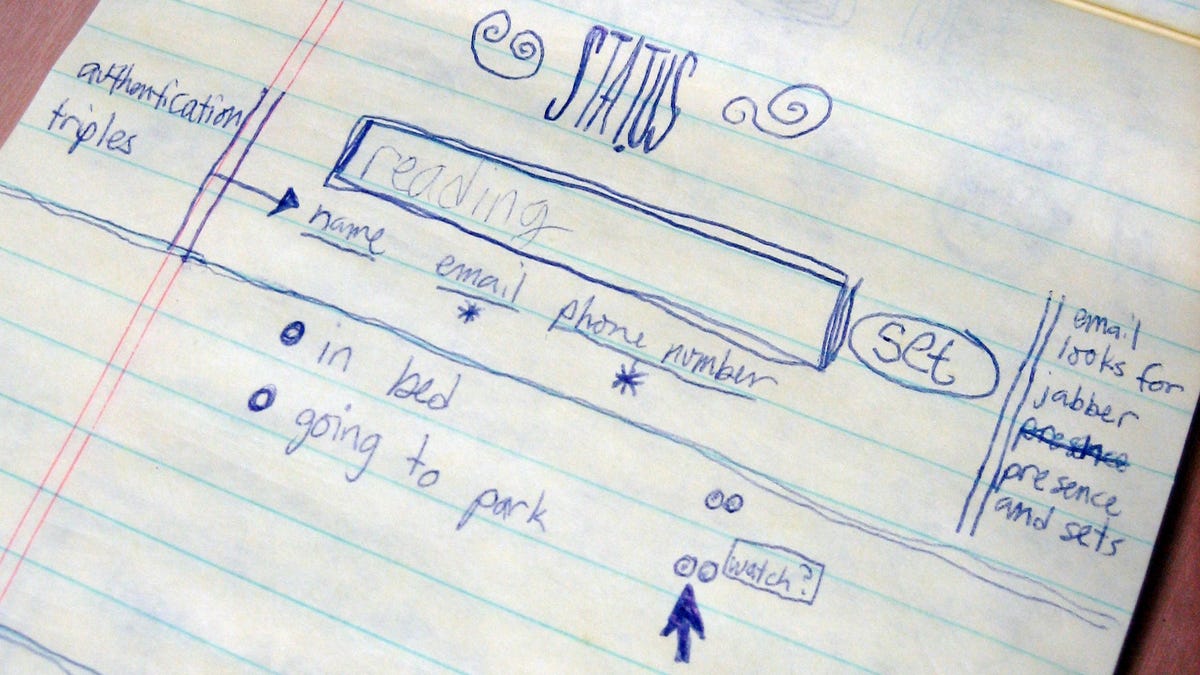
Neurodiversity Design System
This site shares details of a design system which is "informed by the needs of neurodiverse users and learners."
It's specifically focused on "Learning Management Systems' but many of the principles are likely to be applicable in most digital contexts and systems.
An example excerpt on the use of animation: "exaggerated parallax and scroll jacking (or scroll hijacking is when a page scrolls at different speeds and stops at unexpected locations) animations are very likely to trigger vestibular disorders. Unexpected full screen, auto-looping and fast flashing animations will cause a sensation of vertigo and dizziness in a user with a vestibular disorder, to higher degrees users can experience increasing concentration problems and severe migraines and in rare cases even stroke."

How To Create A Weekly Google Analytics Report That Posts To Slack
Data is useless if noone looks at or understands it, this Smashing Magazine tutorial (which admittedly is very technical) details a tool that posts weekly Google Analytics data to Slack in a useful, digestible way.
I suspect there are versions of this idea that'd be effective at every organisation.

Bumble to leverage AI to help users with profile creation and conversations
This week's dystopian AI news sees dating app Bumble investing in new AI-driven features that will "help [their] customers gain confidence to be their best selves".
Of course.

The Broadway play that confronts the horrifying work of online content moderation
An interview in The Verge with Max Wolf Friedlich, the writer of Job.
"Over Job’s brisk 80-minute runtime, the intensity rarely lets up. But as the play’s themes emerge, we start to see the generational divide between its two characters, Gen Z tech worker Jane and her therapist Loyd (played by Sydney Lemmon and Peter Friedman, who you’ll recognize from Succession). It’s a rift created by the internet, dramatized to heighten the psychological damage of being Too Online. So, it makes sense that Jane is revealed to be a content moderator, part of the unsung workforce that witnesses the most harrowing parts of the internet in order to sanitize it for the rest of us."
I've rarely seen a play that has been able to effectively talk about technology and the internet and their combined effect on the modern world.
I don't know if that's a writing issue or a theatre issue, but Job sounds interesting

Koszary on (k)content
Adam Koszary (formerly of the MERL, the RA, Tesla, and generally an interesting voice on social media and content in the cultural sector) has started a new newsletter "Welcome to Content of the Week, where I choose the Content that Contented me the most and talk about why it’s good Content."
In the first edition he looks at the recent TikTok post from the Beamish Museum and shares some thoughts about why it works.
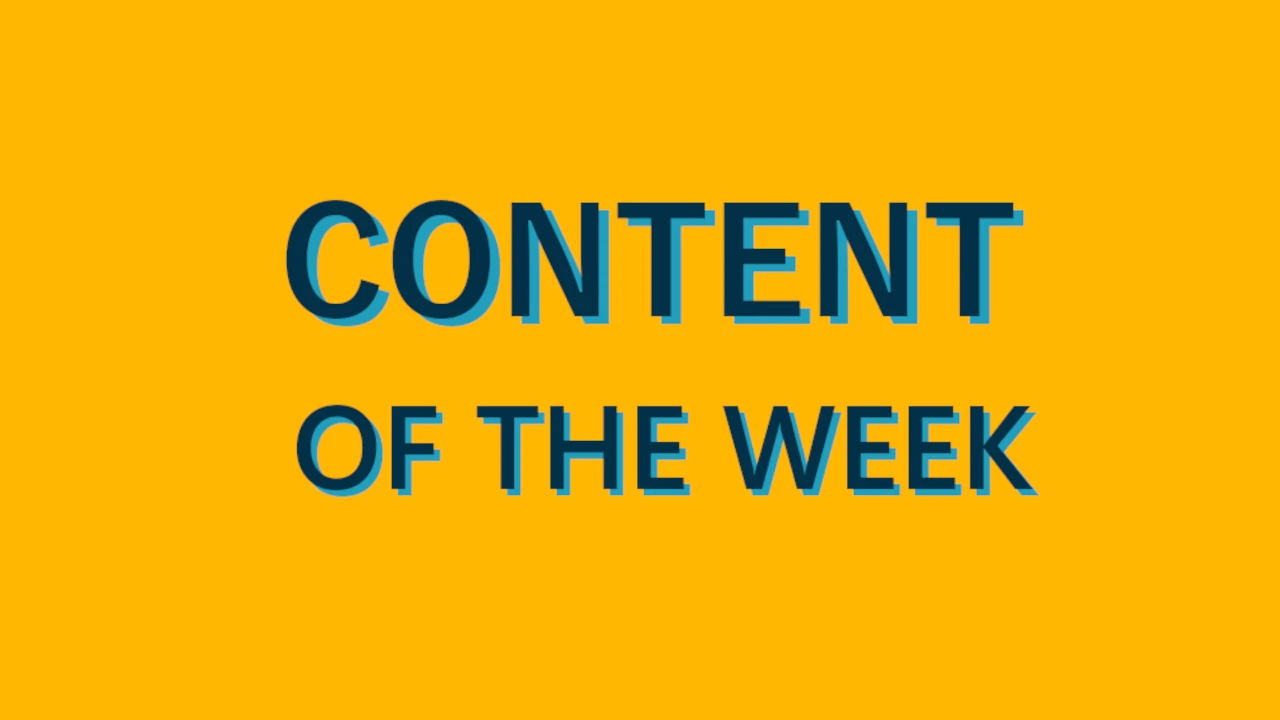
This week's consumption
I finished reading Hisham Matar's The Return which is beautiful, poetic, evocative and also deeply deeply sad. I also read Vera Wong's Unsolicited Advice for Murderers by Jesse Q. Sutanto, which is much better, charming, and more fun than the quite bad title might suggest.
I baked a lot of bread this week, this recipe for potato sourdough, and this one for sourdough focaccia both proved extremely tasty.
I revisited Shearwater's excellent 2012 album, Animal Joy. The tracks Animal Life and You as You Were are particularly lovely.
I watched quite a few videos of Low playing live from around 2018. Like this performance for effect pedal maker, EarthQuaker Devices.
This then sent me on a bit of a hunt to find out more about the production of their Double Negative album, which lead me to this thread on the music production forum, Gearspace, in which the producer of the album (real name: B.J. Burton, forum username: Noize919) answers (a lot of) questions from forum members (in a lot of detail), which is quite fun and seemingly entirely spontaneous.
I also saw this interesting tidbit on Bluesky (or you could replace 'interesting tidbit' with 'yet another reason why English is maddening') - there's more about these rules in this BBC article:
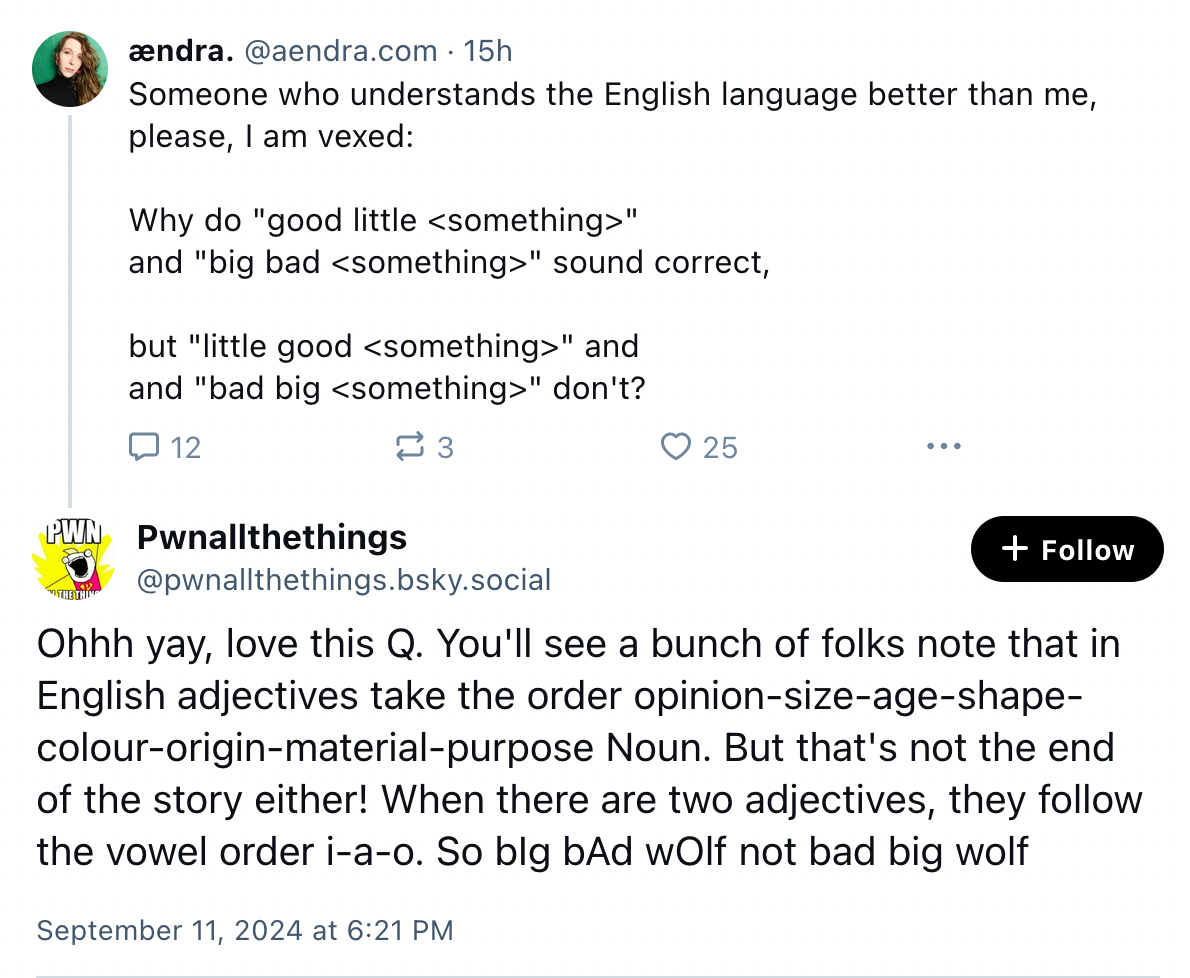
And lastly, here are some entertaining reactions (on Twitter/X) to some of the more unhinged things that Donald Trump said in this week's presidential debate:
See you next month.








